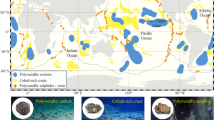Abstract
Since the 1960s, researchers have studied catastrophes and have predicted that the Earth’s Systems are moving towards a new equilibrium. We are heading towards a new Ice Age. The question is whether mankind can withstand it. Eighty-two percent of the world’s largest cities are situated on coastal areas cf. (Creel in Ripple effects: population and coastal regions, PRB. https://www.prb.org/resources/ripple-effects-population-and-coastal-regions/, 2003). Urbanization and deterioration of mangroves, the marine ecology and coastal environments bring cities in the front line of impact with the climate crises. While, ever since the 1970s, oceans have absorbed 93% of the excess atmospheric heat from greenhouse gas emissions cf. (Ocean Warming in IUCN. https://www.iucn.org/resources/issues-briefs/ocean-warming, 2017), megacities continue to grow over a boiling pot. What comes next remains to be seen, yet this paper proposes the development of an “Ocean Mission Architecture Optimization” (OMAO) as a step forward in combining interconnected proactive plans for future Ocean and land-use sustainability.
Similar content being viewed by others
Availability of Data and Material
Not applicable.
Code Availability
Not applicable.
References
Britannica, René Frédéric Thom: French mathematician. https://www.britannica.com/biography/Rene-Frederic-Thom. Accessed 23 Aug 2022
Center for Climate and Energy Solutions (C2ES) Heat waves and climate change. https://www.c2es.org/content/heat-waves-and-climate-change/. Accessed 7 July 2022
Climate Citizen (2012) Is climate change causing an exponential rate of ice sheet mass loss, sea level rise?. https://takvera.blogspot.com/2012/12/is-climate-change-causing-exponential.html. Accessed 7 Aug 2022
Creel L (2003) Ripple effects: population and coastal regions, PRB. https://www.prb.org/resources/ripple-effects-population-and-coastal-regions/. Accessed 8 Sept 2022
Gammelby PF (2020) Global warming means more frost damage to trees in Europe and Asia, Aarhus University. https://nat.au.dk/en/about-the-faculty/news/show/artikel/global-opvarmning-giver-traeer-i-europa-og-asien-flere-frostskader-1. Accessed 1 Sept 2022
Hansen J, & Sato M, Updating the climate science: What path is the real world following?. http://www.columbia.edu/~jeh1/. Accessed 23 Aug 2022
IACS IMO POLARIS: IACS overview, IACS: 4th PAME Shipping Best Practices Information Forum, London. https://pame.is/images/03_Projects/Forum/4th_meeting/Presentations/Session_4_-_James_Bond.pdf. Accessed 8 Oct 2022
Lindsey R (2022) Climate change: global sea level NOAA Climate.gov: Science & Information for a Climate-Smart Nation. https://www.climate.gov/news-features/understanding-climate/climate-change-global-sea-level. Accessed 23 Aug 2022
McCarthy J (2021) Climate crisis: what’s the difference between a rise of 1.5, 2, and 3 degrees celsius?, Global Citizen. https://www.globalcitizen.org/en/content/the-difference-in-global-warming-levels-explained/. Accessed 18 July 2022
NASA Earth Observatory, Bad news, good news. https://earthobservatory.nasa.gov/features/HeatBucket/heatbucket4.php. Accessed 18 Sept 2022
Ocean Warming (2017) IUCN. https://www.iucn.org/resources/issues-briefs/ocean-warming. Accessed 18 Sept 2022
RACE-Synthesis, Global Change Ocean and climate modelling. https://race-synthese.de/ocean-and-climate-modelling. Accessed 20 July 2022
Schleussner CF, The Paris Agreement 1.5C temperature goal, Climate analytics. https://climateanalytics.org/briefings/15c/. Accessed 1 Oct 2022
Teller E (1979) Energy from Heaven and Earth, W. H. Freeman and Company, San Francisco.
United Nations Treaty Collection (2015) Paris Agreement Chapter XXVII Environment. https://treaties.un.org/pages/ViewDetails.aspx?src=TREATY&mtdsg_no=XXVII-7-d&chapter=27&clang=_en. Accessed 10 July 2022
Water Science School (2019) How much water is there on Earth? USGS Science for a Changing World. https://www.usgs.gov/special-topics/water-science-school/science/how-much-water-there-earth. Accessed 7 June 2022
Whitmarsh F, Zika J, & Czaja A (2015) Ocean heat uptake and the global surface temperature record Imperial College London: Grantham Institute Briefing Paper No14. https://www.imperial.ac.uk/media/imperial-college/grantham-institute/public/publications/briefing-papers/Ocean-heat-uptake---Grantham-BP-15.pdf. Accessed 7 June 2022
Author information
Authors and Affiliations
Contributions
The sole author of this article is Stamatina Th. Rassia.
Corresponding author
Ethics declarations
Ethics Approval
Not applicable.
Consent to Participate
Not applicable.
Consent for Publication
Not applicable.
Conflict of Interest
The author declares no competing interests.
Additional information
Publisher's Note
Springer Nature remains neutral with regard to jurisdictional claims in published maps and institutional affiliations.
Rights and permissions
Springer Nature or its licensor (e.g. a society or other partner) holds exclusive rights to this article under a publishing agreement with the author(s) or other rightsholder(s); author self-archiving of the accepted manuscript version of this article is solely governed by the terms of such publishing agreement and applicable law.
About this article
Cite this article
Rassia, S.T. Boosting the Earth’s “Immune System”: the Development of an “Ocean Mission Architecture Optimization”. Oper. Res. Forum 4, 1 (2023). https://doi.org/10.1007/s43069-022-00183-3
Received:
Accepted:
Published:
DOI: https://doi.org/10.1007/s43069-022-00183-3




